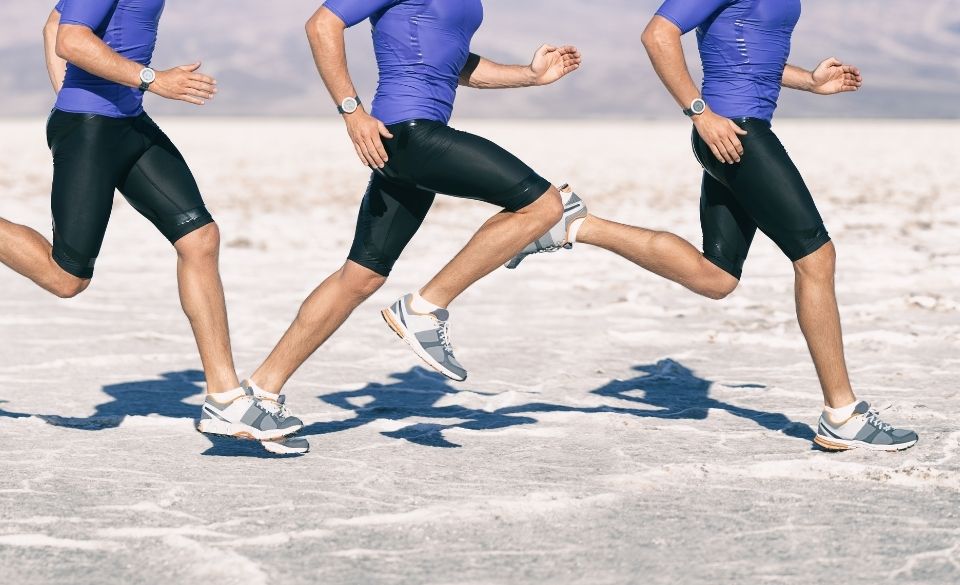
Proper Running Form With Your Feet- The Ultimate Guide
Page Contents
If you want to improve your running performance, it is important to focus on having proper running form with your feet. For some people, this may come naturally. Unfortunately, most people need to work on their technique and foot strike to improve performance and reduce the chances of injury.
With that being said, not everyone can change the way they run. However, making improvements to your foot strike can help enhance your running and help place less stress on your muscles, tendons, bones, and ligaments.
If you are someone that is constantly injured by poor running technique, changing your foot strike could be the next step.
In this article, we discuss proper running form with feet, the different types of running foot strike, and how should your foot should strike the ground when running.
Types of Running Foot Strike
Foot strike is defined when your foot first makes contact with the ground. This is part of your running gait cycle and is an important part of your performance, efficiency, and injury prevention.
There are generally three types of foot strike. These are:
Heel strike
The majority of runners use this form of foot strike. Heel strike running form is when your heel touches the ground before any other part of the foot. Once the heel has touched the ground, the foot rolls forward and shifts the weight onto a flat foot.
Most heel strikers tend to over stride when they run. This can cause a braking motion when they run and may cause more stress to be placed on the heel, hips, and knees. Some research suggests that more than 90% of runners heel strike when they run.
Midfoot Strike
The midfoot strike running form is when the foot primarily lands almost flat. That means your heel and forefoot most of the time will ground almost simultaneously.
A midfoot strike technique is popular with experienced runners and also distance runners, as it prevents over striding. It also can help lower the stress placed through the knees and hips, as the foot helps cushion a lot of the impact from landing.
Forefoot Strike
Forefoot running strike is the technique where the balls of the foot touch the ground first. It is also known as running on your toes.
A forefoot strike is largely common with sprinters and shorter-distance runners. However, it does end up placing more stress on your calf muscles and Achilles tendons.
While running on your toes gives you a light and springy feeling, it is not typically recommended for distance runners because of the stress it places on the calf, Achilles, toes, and ankles.
Proper Running Form With Feet – What Should You know?
Unfortunately, not everyone suits a specific type of foot strike. Some runners do better with a gentle heel strike, while others a suited to midfoot striking. However, when it comes to sprinters they are more suited to a forefoot running technique as it helps leg turnover and explosiveness.
For most people, finding an efficient foot strike is the best way to go about it. That means refining what you already do naturally.
For example, if you are already a natural heel striker, you should try to refine your running form so your heel strike is less aggressive. By doing this, you will help reduce the stress on your knees and hips. This will not only reduce the chances of injuries common with heel strikers but also make you a more efficient runner.
Alternatively, if you are a forefoot striker and constantly have tight calf muscles or Achilles tendon injuries, you should try to refine your landing. By moving the load from the ball of your foot to slightly behind, you will help reduce the stress placed on the calves and tendons in the lower leg.
However, the truth of the matter is, that no matter which foot strike you use, you are still susceptible to injuries through overuse and repetition.
Changing your foot strike from the heel to midfoot may end up reducing some injuries caused by heel striking. However, it may end up causing new issues for you.
Instead, refine the natural landing you already have. Make small changes over a long period. That way you will be less susceptible to injuries.
Remember, proper running form is all about avoiding common mistakes. That also means not trying to force the feet to land in a position that is unnatural for your body.

How Should Your Foot Strike The Ground When Running?
Even though the midfoot strike is the most economical way to run, it doesn’t mean it is best suited to all runners. So, how should your foot strike the ground when running?
The proper running form with your feet involves landing with the ankle beneath a flexing knee. If you land with the foot further ahead of the body, you will end up braking each time you run (heel striking). However, if you are a heel striker naturally, you may find that your heel and ankle land in the correct position. If that is the case, there may be no need to change your entire landing.
The best form of foot strike revolves around the position of each landing. Are your hips inline? Do you pronate? Do you over stride?
These are all questions you need to ask yourself before changing your technique.
If you are unsure how you land or what type of foot strike you have, a gait analysis is the best way to see your running technique. Once you can see your landing and the alignment of your body when you run, you will be able to refine small portions of your foot strike.
Alternatively, try increasing the cadence you run at. By doing this you will naturally incur a more gentle heel strike. Alternatively, if you are a forefoot runner, try to slow the cadence down slightly, as this will help shift your landing further behind the ball of the foot.
How To Correct Heel Strike Running?
If you are naturally a heel strike but are constantly dealing with injuries, you may need to move to a more midfoot position when landing.
However, it is important to know those midfoot runners still tend to touch the ground when they land. The difference is a midfoot runner’s heel will touch the ground once the midfoot has made contact with the ground, rather than a direct heel landing.
To correct a heel strike landing, there are a few things you can do.
One of the best ways to correct heel strike is to practice specific running drills 2-3 times per week, like:
– Power skips
– High Knees
– Butt Kicks
– A-Step
Adding regular drills to your running will not only help your posture but help correct the placement of the foot when landing.
Alternatively, sometimes a shoe with less drop or less structure can help to modify your foot strike. However, it is important to slowly progress into a pair of these shoes. Otherwise, you may end up with more injuries than before you started changing your running technique.
Regardless of how you try to correct your heel strike, it is important to reduce the intensity and the duration of your runs. That way you can slowly build up again with your new technique and let the body’s muscles and tendons adjust to the new load.



